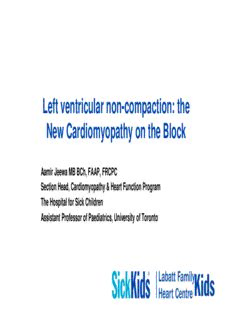
Non Compaction PDF
Preview Non Compaction
Left ventricular non-compaction: the New Cardiomyopathy on the Block Aamir Jeewa MB BCh, FAAP, FRCPC Section Head, Cardiomyopathy & Heart Function Program The Hospital for Sick Children Assistant Professor of Paediatrics, University of Toronto Disclosures I have no conflicts of interest or relevant financial relationships related to this presentation. Left ventricular non-compaction (LVNC) • First described in 1920s • Most recently recognized as a distinct form of cardiomyopathy • Can be associated with LV dilation, hypertrophy, systolic or diastolic dysfunction, and/or congenital heart disease • Prominent trabeculae and deep intertrabecular recesses, resulting in thickened myocardium with two layers consisting of non-compacted myocardium and a thin compacted layer of myocardium • Numerous genes have been implicated in addition to X- linked/chromosomal and familial disorders Miyake and Kim, Card Electro Clin 2015 From: Left ventricular non-compaction revisited: a distinct phenotype with genetic heterogeneity? Eur Heart J. 2011;32(12):1446-1456. doi:10.1093/eurheartj/ehq508 Eur Heart J | Published on behalf of the European Society of Cardiology. All rights reserved. © The Author 2011. For permissions please email: [email protected] Pathogenesis • The developing embryological heart is a loose mesh of muscle fibres • During gestation, this mesh coalesces or condenses to compact myocardium and usually this process is more complete in the LV than the RV • Failure in the compaction pathway is thought to occur in LVNC • The “crypts” or recesses usually do not communicate with the coronary circulation although the trabeculations are theoretically at risk for sub-endocardial ischemia Trabeculations Genetics of LVNC • Genetically heterogeneous • Can be associated with chromosomal abnormalities • Tri 21, 18, 13, 1p36 del etc • Reported in multiple syndromes: • Barth • Mitochondrial • Myotonic dystrophy Genetics of LVNC • Reported mutations in: • LMNA • ZASP (LBD3) • Associated with myofibrillar myopathy: progressive muscle weakness • DTNA • Cytoskeleton of dystrophin complex • Sarcomere genes (i.e. MYH7, MYBPC3, TTN, TNNT2 etc) • If LVNC + Ebstein’s anomaly (MYH7) LVNC and CHD
Description: